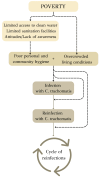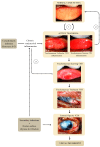Insights into Pathogenesis of Trachoma
- PMID: 39203386
- PMCID: PMC11355952
- DOI: 10.3390/microorganisms12081544
Insights into Pathogenesis of Trachoma
Abstract
Trachoma is the most common infectious cause of blindness worldwide. This review investigates the pathogenesis of trachoma, focusing on its causative agent, transmission pathways, disease progression, and immune responses. Trachoma is caused by serovars A-C of the bacterium Chlamydia trachomatis (Ct). Transmission occurs through direct or indirect exchanges of ocular and nasal secretions, especially in regions with poor hygiene and overcrowded living conditions. The disease is initiated in early childhood by repeated infection of the ocular surface by Ct. This triggers recurrent chronic inflammatory episodes, leading to the development of conjunctival scarring and potentially to trichiasis, corneal opacity, and visual impairment. Exploring the pathogenesis of trachoma not only unveils the intricate pathways and mechanisms underlying this devastating eye disease but also underscores the multifaceted dimensions that must be considered in its management.
Keywords: chlamydia trachomatis; pathogenesis; trachoma; trachomatous scarring; trachomatous trichiasis; transmission.
Conflict of interest statement
The authors declare no conflicts of interest.
Figures





References
-
- Flaxman S.R., Bourne R.R.A., Resnikoff S., Ackland P., Braithwaite T., Cicinelli M.V., Das A., Jonas J.B., Keeffe J., Kempen J.H., et al. Global causes of blindness and distance vision impairment 1990–2020: A systematic review and meta-analysis. Lancet Glob. Health. 2017;5:e1221–e1234. doi: 10.1016/S2214-109X(17)30393-5. - DOI - PubMed
-
- World Health Organization Trachoma. [(accessed on 1 April 2024)]. Available online: https://www.who.int/news-room/fact-sheets/detail/trachoma.
-
- World Health Organization Ending the Neglect to Attain the Sustainable Development Goals: A Road Map for Neglected Tropical Diseases 2021–2030. [(accessed on 2 April 2024)]. Available online: https://www.who.int/publications/i/item/9789240052932.
Publication types
LinkOut - more resources
Full Text Sources

